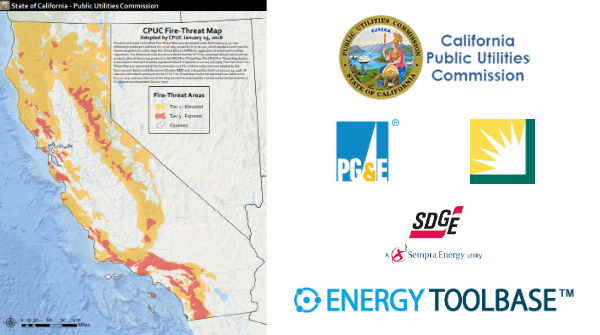The California Public Utilities Commission (CPUC) recently finalized a decision, which set new rules for the SGIP Equity and Equity Resiliency budget. These two set-aside programs within the Self-Generation Incentive Program (SGIP) provide lucrative incentives for energy storage projects for low-income customers (Equity Budget) and for projects that provide resiliency benefits to customers or communities facing risks of wildfire (Resiliency Budget) in the state.
The incentive levels for both set-aside programs are very lucrative: $850/kWh for qualified Equity Budget projects and $1,000/kWh for Equity Resiliency Budget projects. The CPUC explicitly stated in their final decision that the intention was to set the incentive “level likely to fully or nearly fully subsidize the installation of a storage system.” Additionally, $10 million dollars at the $1,000/kWh incentive level has been set-aside for storage incentives to support pilot projects in San Joaquin Valley disadvantaged communities.
The CPUC has directed the SGIP Program Administrators (PA’s) to update the SGIP program handbook within 90 days to implement the changes adopted in their decision. The expected start date for when applications will be accepted under the new rules will be sometime between January 1 and April 1, 2020.
SGIP Equity Budget
The original SGIP Equity Budget was established for low-income customers in 2016 and carved out 25% of SGIP funds. The program languished and never had meaningful uptake, which the CPUC acknowledged in their decision. This was because the incentive levels were set at the same amount as the general program. In the new decision, the Equity Budget incentive was increased to $850/kWh, which the CPUC said was done to “improve the likelihood of program participation.”
The new Equity Budget will rollover funds from the older program, with initial funding set at ~$7 million for residential projects and ~$63 million for non-residential projects. These budgets are expected to increase after the implementation of SB 700, which we previously summarized here.
Eligibility criteria:
- Single-family households: “income is less than 80% of Area Median Income and house has an affordable housing designation subject to a resale restriction or an equity sharing agreement.”
- Multifamily housing: “located in a Disadvantaged Community (DAC) or at least 80% of the households have incomes at or below 60% of the area median income.” Also, properties approved in the Solar on Multifamily Affordable Housing (SOMAH) program or the Multifamily Affordable Solar Housing (MASH) program are eligible.
- Non-residential customers: “located in a Disadvantaged Community (DAC) or low-income community, which is defined as a census tract with median household income below 80% of statewide median income.” This can include a government agency, educational institution, non-profit organization, or small business.
Equity Resiliency Budget:
The new Equity Resiliency Budget is designed to provide rebates for vulnerable customers located in high fire-threat districts (HFTD’s), which can be viewed on these maps. The Equity Resiliency Budget incentive level will be set at $1,000/kWh, which is very lucrative “level likely to fully or nearly fully subsidize the installation of a storage system.” To deter developers from artificially inflating the installation price of storage systems, the CPUC is directing the PA’s to create a price cap and prevent vendors/developers from selling a storage system that is greater in price than a comparable system that does not receive incentives.
The initial Equity Resiliency budget will be set at $100 million, which may increase further with the implementation of SB 700. The initial distribution of the budget by utility territory will be set at: $44m for PG&E, $34 million for SCE, $13 million for SDG&E, and $9 million for SoCalGas.
Eligibility criteria:
- Residential customers: “the Commission should define residential customers with critical resiliency needs as customers that: (a) are located in a Tier 3 or Tier 2 HFTD; and, (b) are one of the following: (i) eligible for the equity budget; (ii) a medical baseline customer; or (iii) a customer that has notified their utility of serious illness or condition that could become life-threatening if electricity is disconnected.”
- Non-residential customers: “the Commission should define non-residential customers as having critical resiliency needs if they are located in a Tier 2 or Tier 3 HFTD and provide critical facilities or infrastructure as defined in this decision for a community that is located in a Tier 2 or Tier 3 HFTD and eligible for the equity budget.” Page 117 of the CPUC decision lists the specific types of non-residential critical resiliency needs customers that qualify.
- Residential and non-residential customers who have experienced, and been affected by two or more Public Power Safety Shutoffs (PSPS).
What’s the Net Effect?
Given that the new SGIP Equity and Resiliency Budget incentive levels are so rich, it’s fair to expect that there will be a very strong demand for rebate reservations. Standalone storage or solar + storage projects that qualify for Equity or Resiliency budget SGIP incentives will undoubtedly offer very attractive project economics. Many leading energy storage developers we’ve talked to are aware of these new programs and are likely lining up projects now in anticipation of the application window opening in Q1 of 2020.
Updates in Energy Toolbase
We will load the new Equity and Resiliency budget SGIP incentives into Energy Toolbase after the SGIP Handbook gets updated to reflect these new rules and procedures. This is likely to coincide with the other SGIP program changes getting implemented, most notably the greenhouse gas emissions (GHG) reduction requirement. In the meantime, users can easily create custom placeholder incentives to reflect the new incentive levels in their financial analysis and sales proposals. Contact your account manager if you would like assistance with this.



